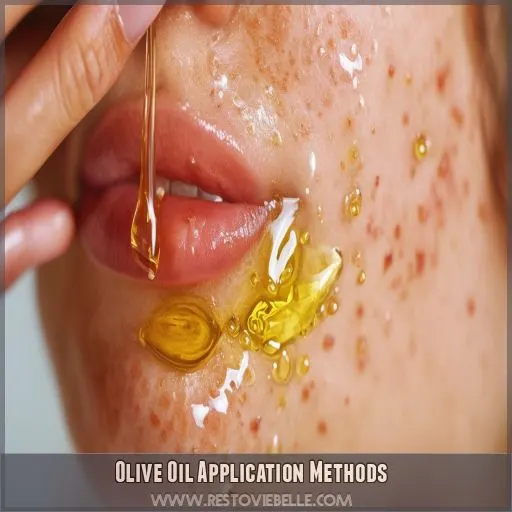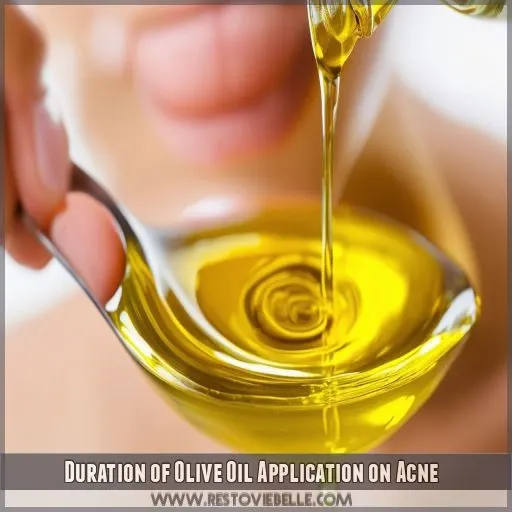This site is supported by our readers. We may earn a commission, at no cost to you, if you purchase through links.
 Did you know approximately 50 million Americans struggle with acne each year?
Did you know approximately 50 million Americans struggle with acne each year?
If you’re looking for a natural and innovative solution, understanding how to use olive oil for acne treatment can offer a promising approach.
Olive oil, rich in antioxidants and vitamins, is effective in fighting acne and nourishing your skin.
This article explores the benefits of olive oil, safe application techniques, and potential adverse effects, providing you with the knowledge to achieve clearer skin using a basic kitchen ingredient.
Table Of Contents
- Key Takeaways
- How to Use Olive Oil for Acne Treatment?
- How Olive Oil Works for Acne
- Using Olive Oil Safely on Acne-Prone Skin
- Olive Oil Application Methods
- Duration of Olive Oil Application on Acne
- Washing Off Olive Oil From the Face
- Combining Olive Oil With Other Skincare Ingredients
- Potential Side Effects of Using Olive Oil for Acne
- Addressing Dryness Caused by Olive Oil
- Frequently Asked Questions (FAQs)
- Can we apply olive oil on an acne face?
- How long to leave olive oil on face?
- Can I rub olive oil on my face?
- Should I put olive oil on my face before or after moisturizer?
- How should I store olive oil?
- How does olive oil remove makeup?
- How often should I use it for acne?
- Can I use olive oil on its own?
- What are some natural alternatives?
- Conclusion
Key Takeaways
Dive into the world of Olive oil! Rich in antioxidants and vitamins, this golden elixir isn’t just for salads; its antibacterial properties can help fight acne and soothe your skin. When incorporating olive oil into your acne-fighting arsenal, remember that balance is crucial. Experiment with different application techniques and combinations with other ingredients to determine what works best for your unique skin type. Stay vigilant for any skin irritation, signs of pore-clogging, or dryness as you would with any new skincare product, especially when treating acne. Remember, properly washing off olive oil is as important as its application, so follow a gentle cleansing routine to ensure your skin feels clean, refreshed, and ready to take on the world each day.
How to Use Olive Oil for Acne Treatment?
To treat acne with olive oil, start by gently massaging a small amount onto your freshly cleansed face.
After a few minutes, rinse with lukewarm water.
Olive oil’s natural antibacterial properties help fight breakouts, and its vitamin E content promotes scar healing.
If you have sensitive or acne-prone skin, try combining it with your daily moisturizer to avoid potential pore-clogging issues.
Begin with short applications to gauge your skin’s reaction, always keeping in mind that less is more. Too much olive oil might dry your skin.
Stay tuned to discover the ideal combination of olive oil with other skincare ingredients for optimal results.
How Olive Oil Works for Acne
Olive oil boasts a multitude of benefits for your skin.
It is rich in antioxidants and has anti-inflammatory properties, which help reduce redness and irritation associated with acne breakouts.
Olive oil also initiates the healing process for acne scars and minor wounds.
Furthermore, olive oil is an effective cleanser, removing excess oil, dirt, and makeup.
Its antibacterial nature helps ward off infections and promotes the healing of wounds.
Additionally, olive oil is an excellent moisturizer, forming a protective, hydrating barrier on the skin, locking in moisture for long-lasting hydration.
While olive oil has mild comedogenic properties, it can also act as a stripping agent for harmful oils, making it a potential solution for acne-prone skin.
The presence of beneficial fatty acids and vitamins further enhances the skincare benefits of this natural oil.
Using Olive Oil Safely on Acne-Prone Skin
Olive oil is a versatile ingredient offering multiple benefits for skin health. Understanding your skin type and its reaction to olive oil is key. While its mild comedogenic nature can lead to pore clogging, it’s also an efficient stripping agent for harmful oils, making it a potential acne-fighter.
The trick is to experiment and find a balance. Olive oil’s characteristics can change when combined with other ingredients, so discovering the right mixtures for your skin is vital. Using olive oil with active ingredients may prevent comedogenic issues.
Additionally, introducing olive oil through carefully crafted, highly-rated face products can provide a positive first impression and highlight its healing abilities. This approach lets you enjoy its benefits without worries over pure oil application.
Olive Oil Application Methods
To apply olive oil for acne, you can use it directly on your skin by massaging a small amount onto your face and then rinsing it off. Alternatively, mix it with your regular moisturizer to enhance hydration without overwhelming your skin.
Applying Directly to the Skin
Applying olive oil directly to your skin is a simple and effective way to access its benefits.
Used sparingly, olive oil locks in moisture with its occlusive nature and can be applied to damp skin after a shower.
A gentle, natural cleanser, it is ideal for removing makeup, and can be used daily for non-sensitive, non-acne-prone skin.
The vitamin E content promotes wound healing and addresses various skin concerns. However, it is important to be mindful of potential side effects, especially if you have sensitive or acne-prone skin. Always exercise caution.
Mixing With Moisturizer
Thinking of mixing olive oil with a moisturizer? The key is in finding the right balance and moisturizer type for your skin. Start with a conservative amount of olive oil, gradually increasing as needed, to prevent an oily excess.
Moisturizers vary in consistency, so a little trial and error can help you discover the ideal blend for your unique skin type. Sometimes, a light, gel-based moisturizer pairs well with olive oil, resulting in happy, healthy skin.
Remember to gently massage the mixture onto your skin in circular motions, taking a gentle, tender approach.
Duration of Olive Oil Application on Acne
The duration of olive oil application on your skin depends on your skin type and desired outcomes.
For acne management, blend olive oil with other active ingredients to counteract its potential comedogenic properties.
While olive oil effectively removes harmful oils, its oleic acid content can impact your skin’s barrier function, sometimes causing dryness.
Pay attention to how your skin responds and adjust the application time accordingly. Typically, a brief application of a few minutes can offer cleansing and moisturizing benefits without causing side effects.
Washing Off Olive Oil From the Face
After applying olive oil to your face, it’s important to properly wash it off so your skin feels clean and refreshed. Here’s a simple guide:
- Step 1: Dampen your face with lukewarm water. Steer clear of very hot or cold water, as this can be harsh on your skin.
- Step 2: Go in with a gentle, mild cleanser. Take a small amount, and gently massage it onto your face in circular motions, paying attention to the areas you applied the olive oil.
- Step 3: Rinse well with lukewarm water, making sure to remove any residue of the cleanser and olive oil.
- Step 4: Gently pat your face dry with a soft, clean towel. Be kind to your skin and avoid any rubbing or tugging.
Combining Olive Oil With Other Skincare Ingredients
Olive oil’s versatility extends to its ability to seamlessly blend with other skincare ingredients, enhancing your routine. Here are some key insights on combining olive oil with other products:
- Oil blends: Olive oil complements other natural oils, creating nourishing blends. Try mixing it with lighter options like sunflower seed, argan, or jojoba oil for a balanced, hydrating boost without the grease.
- Custom creations: Experiment with adding a few drops of olive oil to your daily moisturizer or serum. This easy step enhances their hydrating power, making them even more effective.
- Vitamin boost: Being rich in vitamins E and K, olive oil provides protective benefits for your skin. Combining it with other vitamin-rich ingredients creates a powerful antioxidant cocktail for a healthy complexion.
- Emulsifying magic: One of olive oil’s standout qualities is its ability to emulsify with water. This makes it a perfect addition to toners or lightweight lotions, resulting in a simple yet effective emulsion that refreshes and hydrates your skin.
- Makeup removal made simple: Olive oil easily dissolves stubborn waterproof makeup. Pair it with a gentle cleanser or micellar water for a nourishing and effective makeup remover.
These combinations highlight olive oil’s versatility in skincare routines, allowing you to personalize and enhance the performance of your products for improved results.
Potential Side Effects of Using Olive Oil for Acne
While olive oil is celebrated for its skin-enhancing properties, it’s important to remember that everyone’s skin is unique, and what works for some may not work for others. Here are some potential side effects to keep in mind when using olive oil for acne:
- Skin irritation: While olive oil is known for its calming attributes, it can irritate sensitive skin.
- Comedogenic properties: Olive oil’s mildly comedogenic nature means it can clog pores and cause acne breakouts, which is the opposite of what you want.
- Eczema flare-ups: It has the potential to trigger eczema flare-ups, so be cautious if you have this skin condition.
- Sensitivity: Pay attention to your skin’s reaction, as olive oil may increase sensitivity for some.
Addressing Dryness Caused by Olive Oil
While olive oil is popular for its moisturizing properties, it can sometimes result in skin dryness, a common issue for those with sensitive or acne-prone skin. Here are some tips to tackle and prevent dryness caused by olive oil:
- Go for a lighter option: Choose a moisturizer formulated with a lighter, more fluid olive oil base. These products are usually designed to be non-greasy, absorbing quickly into the skin, reducing the chances of clogged pores and dry skin.
- Prioritize skin hydration: Keep your skin well-hydrated by drinking ample water throughout the day. Using a hydrating toner or essence before applying olive oil can also help. It creates a moist base for better absorption and lowers the risk of dryness.
- Try different application methods: Apply olive oil to slightly damp skin after showering. This helps lock in moisture. Also, emulsify the olive oil by mixing it with a few drops of water in your palm before application. This may improve absorption, reducing dry skin issues.
- Mix with other natural oils: Combine olive oil with other natural oils like jojoba or avocado oil, known for their skin-hydrating abilities. This can balance out the potential drying effects of olive oil, allowing you to still benefit from its use.
Frequently Asked Questions (FAQs)
Can we apply olive oil on an acne face?
Olive oil may help treat acne for some, but it can also breed acne-causing bacteria and irritate skin. Always patch test and consult a dermatologist before use.
How long to leave olive oil on face?
Olive oil is a versatile natural remedy with a range of benefits for your skin.
Before applying it to your face, it is important to do an allergy test on your forearm, especially if you have sensitive skin.
When using olive oil to treat acne, leave it on your face for around 10 minutes.
You can also use olive oil as a moisturiser, leaving it on overnight or washing it off after 20 minutes.
Can I rub olive oil on my face?
Yes, you can rub olive oil on your face. If you have sensitive or acne-prone skin, do a patch test first. Choose extra virgin olive oil or 100% pure olive oil.
Should I put olive oil on my face before or after moisturizer?
Olive oil should be applied after moisturiser. Oil and water don’t mix, so if you put oil on first, your products won’t work well together. But oil can penetrate moisturiser, so using it last lets it trap hydration within your skin.
How should I store olive oil?
Store olive oil in a cool, dark place, away from heat sources and direct light. To prevent air exposure, use a sealed container. Refrigeration is an option, but the oil will solidify and turn cloudy.
How does olive oil remove makeup?
Olive oil is effective at removing makeup, including stubborn waterproof products, because it dissolves the oils and waxes commonly found in makeup. Apply a small amount to a cotton pad and gently swipe or massage your skin.
How often should I use it for acne?
You should use olive oil for acne treatment once per day. It may take a week or two before you see results.
Can I use olive oil on its own?
It’s not recommended to use olive oil on its own for acne treatment as it can cause irritation, clogged pores, and acne. Speak to your dermatologist before trying it, and always do a patch test first.
What are some natural alternatives?
Natural alternatives to olive oil for acne treatment are oils with low oleic acid and high linoleic acid, including sunflower seed, argan, avocado, jojoba, and rosehip oils. Topical retinoids, needling, essential oils, and microdermabrasion are also viable options. Notably, sugar serves as a natural skin exfoliant, offering both chemical and physical exfoliation to unclog pores and reduce breakouts.
Conclusion
Acne is a common skin concern, affecting approximately 50 million Americans each year.
This article explores how olive oil can be used as a natural remedy for acne-prone skin, thanks to its antioxidant and vitamin-rich properties.
You will learn about the benefits of olive oil for acne treatment, as well as safe application techniques and potential side effects.












